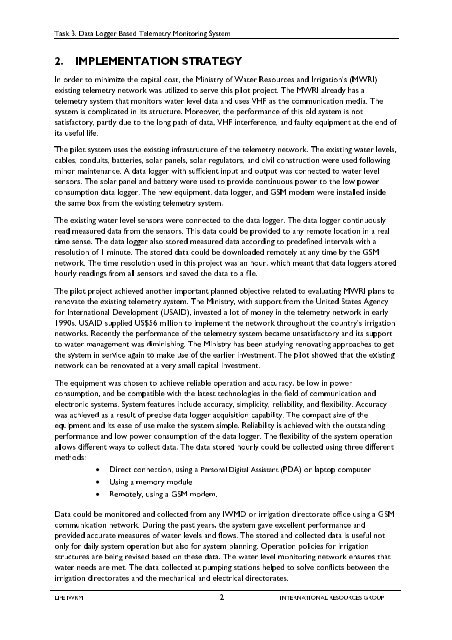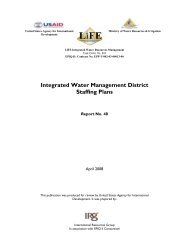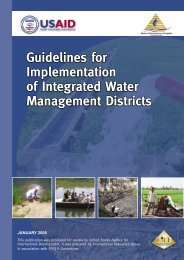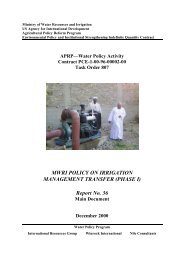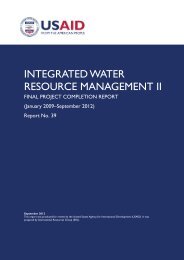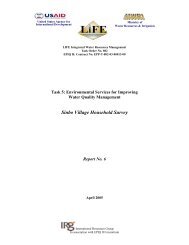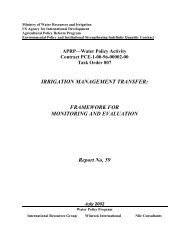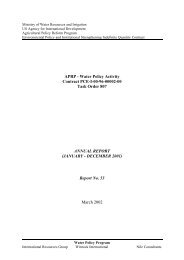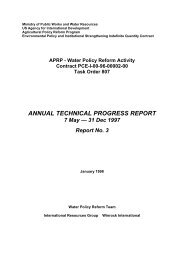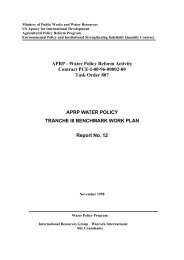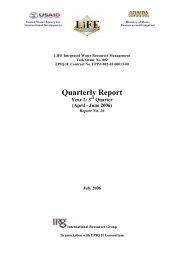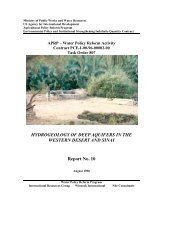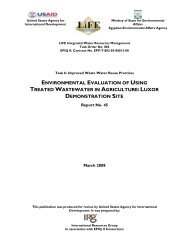Report 44 Task 3 Data Logger Telemetry System
Report 44 Task 3 Data Logger Telemetry System
Report 44 Task 3 Data Logger Telemetry System
You also want an ePaper? Increase the reach of your titles
YUMPU automatically turns print PDFs into web optimized ePapers that Google loves.
order to minimize the capital cost, the Ministry of Water Resources and Irrigation’s (MWRI)<br />
In<br />
telemetry network was utilized to serve this pilot project. The MWRI already has a<br />
existing<br />
system that monitors water level data and uses VHF as the communication media. The<br />
telemetry<br />
is complicated in its structure. Moreover, the performance of this old system is not<br />
system<br />
partly due to the long path of data, VHF interference, and faulty equipment at the end of<br />
satisfactory,<br />
useful life.<br />
its<br />
pilot system uses the existing infrastructure of the telemetry network. The existing water levels,<br />
The<br />
conduits, batteries, solar panels, solar regulators, and civil construction were used following<br />
cables,<br />
maintenance. A data logger with sufficient input and output was connected to water level<br />
minor<br />
The solar panel and battery were used to provide continuous power to the low power<br />
sensors.<br />
data logger. The new equipment, data logger, and GSM modem were installed inside<br />
consumption<br />
same box from the existing telemetry system.<br />
the<br />
existing water level sensors were connected to the data logger. The data logger continuously<br />
The<br />
measured data from the sensors. This data could be provided to any remote location in a real<br />
read<br />
sense. The data logger also stored measured data according to predefined intervals with a<br />
time<br />
of 1 minute. The stored data could be downloaded remotely at any time by the GSM<br />
resolution<br />
The time resolution used in this project was an hour, which meant that data loggers stored<br />
network.<br />
readings from all sensors and saved the data to a file.<br />
hourly<br />
pilot project achieved another important planned objective related to evaluating MWRI plans to<br />
The<br />
the existing telemetry system. The Ministry, with support from the United States Agency<br />
renovate<br />
International Development (USAID), invested a lot of money in the telemetry network in early<br />
for<br />
USAID supplied US$56 million to implement the network throughout the country’s irrigation<br />
1990s.<br />
Recently the performance of the telemetry system became unsatisfactory and its support<br />
networks.<br />
water management was diminishing. The Ministry has been studying renovating approaches to get<br />
to<br />
system in service again to make use of the earlier investment. The pilot showed that the existing<br />
the<br />
can be renovated at a very small capital investment.<br />
network<br />
equipment was chosen to achieve reliable operation and accuracy, be low in power<br />
The<br />
and be compatible with the latest technologies in the field of communication and<br />
consumption,<br />
systems. <strong>System</strong> features include accuracy, simplicity, reliability, and flexibility. Accuracy<br />
electronic<br />
achieved as a result of precise data logger acquisition capability. The compact size of the<br />
was<br />
and its ease of use make the system simple. Reliability is achieved with the outstanding<br />
equipment<br />
and low power consumption of the data logger. The flexibility of the system operation<br />
performance<br />
different ways to collect data. The data stored hourly could be collected using three different<br />
allows<br />
methods:<br />
Direct connection, using a Personal Digital Assistant (PDA) or laptop computer<br />
•<br />
Using a memory module<br />
•<br />
Remotely, using a GSM modem.<br />
•<br />
could be monitored and collected from any IWMD or irrigation directorate office using a GSM<br />
<strong>Data</strong><br />
network. During the past years, the system gave excellent performance and<br />
communication<br />
accurate measures of water levels and flows. The stored and collected data is useful not<br />
provided<br />
for daily system operation but also for system planning. Operation policies for irrigation<br />
only<br />
are being revised based on these data. The water level monitoring network ensures that<br />
structures<br />
needs are met. The data collected at pumping stations helped to solve conflicts between the<br />
water<br />
<strong>Task</strong> 3. <strong>Data</strong> <strong>Logger</strong> Based <strong>Telemetry</strong> Monitoring <strong>System</strong><br />
2. IMPLEMENTATION STRATEGY<br />
irrigation directorates and the mechanical and electrical directorates.<br />
LIFE IWRM 2 INTERNATIONAL RESOURCES GROUP


